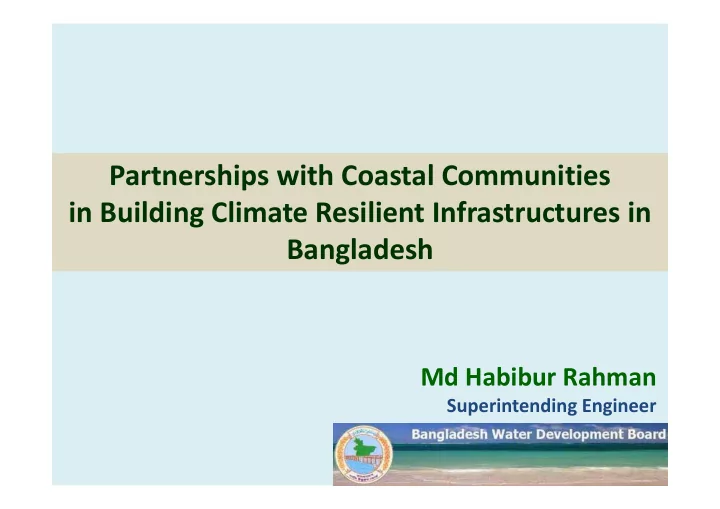

Partnerships with Coastal Communities in Building Climate Resilient Infrastructures in Bangladesh Md Habibur Rahman Superintending Engineer
Geographical Location of Bangladesh Bangladesh
Bangladesh – Largest Delta Cherapunji (in INDIA) Area: 147,570 sq. km Worlds highest rainfall Land : 133,910 sq. km. Population: 150 million (BBS 2011) River System : 24,000 km Trans-boundary River: 57 Nos. Annual Avg. Rainfall : 2300 mm Catchment of G-M-B basin: 1.72 million sq. km. 93% catchment area: outside Bangladesh. Bangladesh experiences flooding every year and severe every 10 years
Coastal Zone of Bangladesh Coastal Zone spans over 710 km along coastline. Population 42 million (BBS 2011), 28% of total population Total area 47,201 sq.km., 32% of total area. 19 districts & 147 Upzilas; 48 upzilas directly exposed.
Coastal Resources & Opportunities Agriculture Shrimp Fisheries Port & Harbor, Ship Building Biodiversity Mangrove Forest Gas & Oil Exploration Tourism Land Reclamation
Coastal Polders • 139 polders, 5355 km embankment • 1.5 mill. Ha land is provided flood protection Bay of Bengal Bay of Bengal • Elevation of 62% coastal land up to 3m & 82% up to 5m above MSL.
Coastal Infrastructures Gabtoli7-vents Regulator Coastal Embankment Multi-purpose Cyclone Shelter Public Toilet Foreshore Protection Work Drainage Canal Housing for Landless River Closure Tubewell
Coastal Polders: Present Scenario Coastal embankment system brought immense benefits to the people living within the polders. Polders were designed originally to protect against the highest tides, without much attention to storm surges. Recent cyclones brought substantial damage to the embankments and threatened the integrity of the coastal polders. Embankment breaches due to cyclones, siltation of peripheral rivers surrounding the embankment caused the coastal polders to suffer from water logging, leading to important environmental, social and economic degradation. 8
Coastal Polders: Present Scenario • Poor maintenance and inadequate management of the polders contributed to internal drainage congestion and heavy external siltation. • Soil fertility and good agriculture production declining due to water logging and salinity increases inside the polders. • systematic approach to upgrade embankment against high tides as well as frequent storm surge with appropriate return period. 9
Coastal Polders: Present Scenario the embankment program needs to be integrated with an afforestation program, particularly on the foreshore, in a view to create greenbelts of mangrove and other species. Restoration of the embankment system is a much needed catalyst to provide resilience to vulnerable communities and to revitalize the coastal zone's ailing socio ‐ economic engine. Development of Partnership and Participation with coastal communities for better management and operation of infrastructures. 10
Stakeholders of Coastal Polders NGO LGI WMO MoCA T MWCA BRDB Coastal Community BIWTA BWDB Coastal Public Polders DoE Sector DPHE Agencies Implementing DoF LGED Agencies DLS Private Sector MoL Service DAE Providers MoI FD
Community involvement - Coastal Development Sub ‐ Polder Committee (SPC) in a Part of a polder/ scheme; Polder Committee (PC): More than one SPCs form a PC for a Polder/ proposed Polder; Local Area Development Committee (LADC) for unprotected area; SPC/PC transformed into Water Management Organization (WMO) for Polder/Systems area; Consultation/Participation/Partnerships with WMO in all stage of Project Cycle.
Organogram of WMO Stages of Different Organization WMA WMG WMG WMG Depends on project/sub-project/scheme size
Major Responsibilities Of WMOs Operation & Maintenance Of Sluice Preventive/Routine Maintenance of Sluice, Khal, Embankment & Other Structures Removal of Cross Bundh, Fishing Traps, Water Hyacinth/Debris & Silt from canal Establishment WMO Office Raising Fund For O & M, WMO establishment Annual Maintenance Plan With BWDB, LGED & UP Liaison & Coordination With All Concerned Receive Training Solving O & M Problems Through Local Initiatives
Development of Maintenance Plan Stakeholders involved are: BWDB LGED LGI (Union Parishad) WMO Types of Maintenance Preventive/Routine: WMO/LGI Periodic: BWDB, LGED/LGI Emergency BWDB, LGED/LGI/WMO Rehabilitation: BWDB, LGED
Gender Balance Women are taking part in discussions during all meetings and in activities of WMGs Distribution of membership WMG: 45% female Distribution of membership WMG Management Committees: 35% female, in important positions like secretary or casher Distribution of FF membership: 38% female NGO credit groups and TUGs mainly female Issues Male members don’t like to see women as chair person, despite their suitability Mobility and household duties
Stakeholder Participation – Income Generation Group meeting, Nursery, Cattle Rearer and Homestead Garden
Way Forward Coastal community partnership is of utmost priority for sustainable coastal development Reengineering of the coastal polders by phases for Sea level rise and storm surge for the safety of life and livelihood of coastal community. There are need of new cyclone shelters in the high risk coastal areas specially in the Barisal and Khulna division Development of early warning of storm surge inundation forecasting for awareness of coastal community
Thank You habibwdb@gmail.com
Cyclone SIDR 2007
Cyclone Aila - 2009
Drainage Problem Drainage Congestion Drainage Congestion August 2006 August 2006 Drainage Improvement Drainage Improvement December 2006 December 2006 22
Problems due to lack of participation Sluice Gate not in operation Deteriorated Embankment Siltation Poor O&M 23
Afforestation No afforestation Reduction of Storm Surge 600 m Afforestation height by Coastal Afforestation width of 600m reduces the Surge Level by Afforestation 50cm
Community Participation Introduction Workshop Project Mission visit Project Mission visit Foreshore Protection Work Dutch Ambassador's visit Mrs. Ambassador Project Mgt. Committee Dutch Embassy official visit Deed of Agreement WMO Meeting
Composition of WMO WMF(Representatives WMF (apex level of from the General scheme) Members of the WMA WMA(Representatives WMA (mid level: from the General tertiary/secondary) Members of the WMG WMG(Women & Men WMG (lowest belonging of all kinds level: village/para) of people of the project.)
Climate Resilient Coastal Polders Polder No: 32
Recommend
More recommend